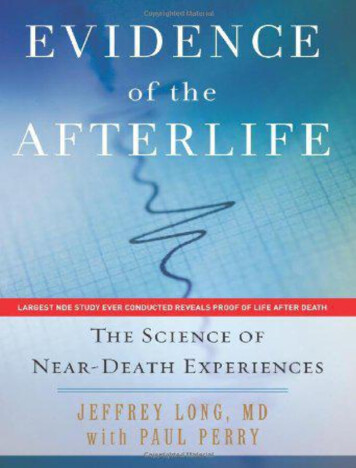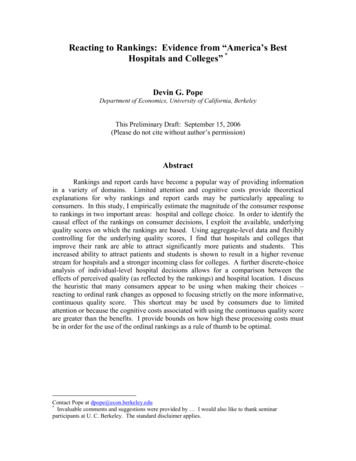
Transcription
Reacting to Rankings: Evidence from “America’s BestHospitals and Colleges” *Devin G. PopeDepartment of Economics, University of California, BerkeleyThis Preliminary Draft: September 15, 2006(Please do not cite without author’s permission)AbstractRankings and report cards have become a popular way of providing informationin a variety of domains. Limited attention and cognitive costs provide theoreticalexplanations for why rankings and report cards may be particularly appealing toconsumers. In this study, I empirically estimate the magnitude of the consumer responseto rankings in two important areas: hospital and college choice. In order to identify thecausal effect of the rankings on consumer decisions, I exploit the available, underlyingquality scores on which the rankings are based. Using aggregate-level data and flexiblycontrolling for the underlying quality scores, I find that hospitals and colleges thatimprove their rank are able to attract significantly more patients and students. Thisincreased ability to attract patients and students is shown to result in a higher revenuestream for hospitals and a stronger incoming class for colleges. A further discrete-choiceanalysis of individual-level hospital decisions allows for a comparison between theeffects of perceived quality (as reflected by the rankings) and hospital location. I discussthe heuristic that many consumers appear to be using when making their choices –reacting to ordinal rank changes as opposed to focusing strictly on the more informative,continuous quality score. This shortcut may be used by consumers due to limitedattention or because the cognitive costs associated with using the continuous quality scoreare greater than the benefits. I provide bounds on how high these processing costs mustbe in order for the use of the ordinal rankings as a rule of thumb to be optimal.Contact Pope at dpope@econ.berkeley.edu*Invaluable comments and suggestions were provided by I would also like to thank seminarparticipants at U. C. Berkeley. The standard disclaimer applies.
1IntroductionRankings and report cards have become a common way for firms to present arange of options to consumers as well as synthesize detailed information into a formatthat can be easily processed. Some popular examples include rankings of colleges (e.g.US News and World Report), restaurants (e.g. Zagat), companies (e.g. Fortune 500),bonds (e.g. Moody’s), and hospitals (e.g. US News and World Report). Additionally,Consumer Reports ranks a wide variety of consumer products each year. Many rankingsystems simply provide an ordered list while others use letter grades (A, B, C, etc.), stars(4-stars, etc.), or other grouping methods.In this analysis, I explore the consumer reaction to the widely-dispersed hospitaland college (undergraduate and graduate) rankings published by U.S. News and WorldReport (USNWR) magazine. Released annually since 1993 as “America’s BestHospitals”, the magazine ranks the top 40-50 hospitals in each of up to 17 specialties.These hospital rankings followed from the success of USNWR’s annual “Best Colleges”magazine issue, which since 1983 has ranked the top research and liberal arts colleges inthe U.S. Since 1987, USNWR has also ranked the top graduate programs in law,business, medicine, and engineering.While the USNWR rankings generate a significant amount of attention whenreleased each year, the extent to which consumers use these rankings remains unclear. Itis possible that the rankings simply confirm what consumers already learned as opposedto providing additional information. Additionally, in the case of hospital rankings, it hasbeen argued that consumers of health care are unresponsive to changes in hospital qualitybecause of potential restrictions such as distance from home, health plan networks, and2
doctor recommendations. Thus, evidence of a large consumer response to hospitalrankings would provide insight into the hospital competition and anti-trust literature.More generally, given the importance of hospital and college choice decisions coupledwith the vast amount of data and resources available to consumers in these markets, itmay be surprising to find that consumers consider a third party’s synthesis of severalpieces of information into a single rank to be beneficial.A fundamental challenge in estimating the causal impact that rankings have onconsumer behavior is the possibility of rank changes being correlated with underlyingquality that is observed by individuals but not by researchers. Estimates of the effect ofrankings on consumer behavior may be biased if this endogeneity is not considered. Tocircumvent this problem, I exploit a special feature of the USNWR hospital and collegerankings: the fact that along with the ordinal rankings, a continuous quality score isprovided for each hospital and college. All number ranks are completely determined bysimply ordering the continuous quality scores. If the rankings are not affecting consumerdecisions, then variables indicating the ability that a hospital or college has to attractpatients or students should be smooth rather than discontinuous as one hospital or schoolbarely surpass another in rank. While flexibly controlling for the underlying continuousquality score, any jumps in patient volume or student applications that occur when ahospital or college changes rank can be considered a lower bound on the causal effect ofthe rankings.Using this identification strategy, I estimate the effect of the hospital rankings onboth patient volume and hospital revenues. The data used for this section of the analysisconsist of all hospitalized Medicare patients in California and a sample of other hospitals3
around the country from 1998-2004. I begin by aggregating the data to the hospitalspecialty level. Using a fixed-effects framework, and while flexibly controlling for theunderlying continuous quality score from which the rankings are determined, I find thatan improvement in a given hospital-specialties’ rank leads to a significant increase inboth the non-emergency patient load and the total revenue generated from nonemergency patients treated by the hospital in that specialty. The point estimates indicatethat an improvement in rank by one spot is associated with an increase in both nonemergency patient volume and revenue of approximately 1%. As a robustness check, Ishow that changes in rank do not have an effect on emergency patient volume or revenuegenerated from emergency patients.To better understand the effect of the rankings on hospital-choice decisionsrelative to other important factors of hospital choice such as distance to hospital, I useindividual-level data to estimate a mixed-logit discrete choice model. Whilecomputationally more taxing than the commonly used conditional logit model, the mixedlogit model provides a more flexible framework and is not prone to bias due to theindependence of irrelevant alternatives (Train, 2003). Under this framework, I estimatethe distribution of preferences over hospital quality (as represented by the hospitalrankings) and geographic proximity. I also allow preference distributions to vary acrossindividuals living in low and high-income zip codes. The results show that both therankings and geographic proximity are important factors in the hospital-choice decisionsof consumers. The average value to an individual of a one-spot change in rank isequivalent to the value placed on the hospital being approximately .15 miles closer to theindividual. The analysis also indicates that the rankings have the largest effect on4
individuals who live nearby the hospitals that experience a rank change. There is littleevidence that the distribution of preferences for distance or the rankings varies acrossindividuals that live in low and high-income zip codes.Overall, the results provide evidence that the USNWR hospital rankings have hada large effect on the hospital choices made by consumers of health care.1 Assuming thesample of hospitals used in this analysis to be representative of the nation as a whole,these hospital rankings have led to over 15,000 Medicare patients to switch from lower tohigher ranked hospitals for inpatient care resulting in over 750 million dollars changinghands over the past ten years.A similar aggregate-level analysis is conducted to analyze the impact of USNWRcollege rankings on the ability of schools to attract high-quality students. Controlling forthe underlying continuous quality score, I find that improvements in rank have asignificant effect on the acceptance rates and the quality of incoming students (asmeasured by SAT, GMAT, LSAT, MCAT, and GRE test scores) for research and liberalarts undergraduate schools and for business, law and medicine graduate programs. I findno effect of the rankings on graduate engineering programs. I show that the size of theseeffects is economically large by comparing them to the effects of other economicvariables that influence college-choice decisions.Along with the estimated impact of the rankings, an interesting finding of thisanalysis is that many consumers are paying attention to the ordinal rankings when a moreinformative measure of quality is available. This simple heuristic adds to an expandingliterature suggesting that consumers often use rules of thumb or shortcuts when making1While I frequently refer to hospital-choice decisions being made by consumers, I cannot rule out thepossibility that doctors, rather than patients, use the rankings when making referral decisions.5
complex decisions (Kahneman and Tversky, 1982, Thaler, 1991). The fact that manyconsumers use the ordinal ranking even in the presence of the more cardinal measurehelps to explain the stylized fact that many magazines and other companies often provideinformation in a ranking or report card format as opposed to more detailed measures attheir disposure.Are consumers acting optimally by using the ordinal ranks as a shortcut whenmaking hospital or college-choice decisions? A consumer who uses only the ordinalrankings in making decisions may choose a hospital/college that, had the moreinformative continuous quality score been used, is inferior in expected utility to another.While this “suboptimal” outcome may occur, it may still be rational for a consumer tostrictly use the ordinal rankings if there are cognitive costs involved with using the morecardinal measure (Simon, 1955). While this issue is very difficult to resolve, onequestion that I address in this paper is how much variation in hospital and college qualitycan be explained by the continuous score that cannot be captured by the ordinal rankings.Answering this question provides bounds on how high the processing costs ofinformation must be in order for consumers to optimally consider only the ordinalranking when making their decisions. I find that the processing costs to a consumer ofusing the cardinal measure rather than the ordinal ranking must be such that it is worthignoring a change in the number of physicians who consider the hospital to be one of thetop five in a given specialty by 1.3%. Similar bounds can be placed on the processingcosts faced by college applicants who use only the ordinal rankings in the decisionprocess.6
The outline of this paper proceeds in the following manner: In Section 2, I reviewthe literature on rankings and report cards. Section 3 provides background informationabout the specific USNWR hospital and college rankings studied in this analysis. InSection 4, I describe the data and empirical strategy employed. The results are presentedin Section 5. Section 6 provides a discussion and concludes.2Literature ReviewTheoretical Literature. Providing information in the format of rankings andreport cards has become ubiquitous. Even when more detailed information about a set ofoptions is available, firms will often synthesize the information into a much simpler rankor final score (Moody’s bond ratings give scores like AA rather than a continuous score,composite SAT/ACT exam scores are given as opposed to the score received on eachsection of the exam, best-seller rankings are provided rather than the actual number ofproducts sold, etc.). Two bodies of literature explain why consumers may express ademand for information to be presented in a ranking or report card format.First, due to cognitive costs, consumers may prefer information at a higheraggregation level because it is simpler to process. It has been argued that consumerstypically use at least a two-stage process when making a choice from a large set ofoptions. The first stage of this process involves the formation of a consideration set fromwhich a final choice will be made during the second stage.2 When collecting andprocessing information about different options is costly, this two-stage process can beshown to be an optimal strategy for a rational agent (Hauser and Wernerfelt, 1990 and2See Shocker et al. (1991) for a nice review of the literature on consideration set formation.7
Roberts and Lattin, 1991). Simple heuristics, such as taking the highest ranked productsin a particular attribute (e.g. quality or price) can be used when generating theseconsideration sets (Gilbride and Allenby, 2004 and Nedungadi, 1990). Thus, firms thatsimplify a massive amount of data into easily classified groups or a ranking are oftenperforming the same task that consumers would themselves have done if the moredetailed information had been provided.The recent literature on limited attention also suggests a reason why consumersmight be attracted to information presented in a rankings or groupings format. Agentswith limited attention are expected to pay attention to information that is relatively salientin some way (Fiske and Taylor, 1991).3 Thus, the basic prediction of the theory oflimited attention is that agents will pay too much attention to salient stimuli (Barber andOdean, 2004 and Huberman and Regev, 2001) and too little attention to non-salientstimuli (Fishman and Pope, 2006, Pope, 2006, and DellaVigna and Pollet, 2006).Synthesizing information into a simple and salient ranking or grouping format maycapture the attention of more consumers than a more complicated and detailedpresentation of the information.Empirical Literature. There is an emergent literature that has documentedconsumer and/or firm responses to published rankings and report cards in a variety ofmarkets (Figlio, 2004, Jin and Leslie, 2003, and Pope and Pope, 2006). More specificallyrelated to this paper, several researchers have studied the effects of rankings in both thehospital and college markets.3They define salience to be X.8
In the health-care industry, studies have addressed the impact of health-planratings on consumer choice (Wedig and Tai-Seale, 2002, Beaulieu, 2002, Scanlon et al.2002, Chernew et al., 2004, Jin and Sorensen, 2005, and Dafny and Dranove, ?). Themajority of these studies find a small, positive consumer response to health-plan ratings.Unlike health plan ratings, however, there is reason to question whether hospital choicescan be influenced by quality ratings. Arguably, location is more of a factor to consumersin the hospital market than in the health plan market. Furthermore, many individuals arerestricted in their hospital choices to hospitals referred to them by their primary-carephysician or that are within their health plan’s coverage. Because of these potentialconstraints, the hospital industry has received a considerable amount of attention in thecompetition and anti-trust literature (see Gaynor and Vogt (1999) and Gaynor (2006) forreviews of the literature on hospital competition). However, even with these restrictions,anecdotal and survey evidence suggest that hospital-choice decisions may be affected byquality rankings. For example, a survey in 2000 by the Kaiser Family Foundation foundthat 12% of individuals said that “ratings or recommendations from a newspaper ormagazine would have a lot of influence on their choice” of hospital (Kaiser FamilyFoundation, 2000).By far, the most studied hospital ratings system has been the New York StateCardiac Surgery Reporting System. Released every 12 to 18 months by the New YorkState Department of Health since 1991, this rating system provides information regardingthe risk-adjusted mortality rates that each hospital experienced in their recent treatment ofpatients needing coronary artery bypass surgery. Studies estimating the consumerresponse to these ratings have produced mixed results. Cutler, Huckman, and Landrum9
(2006?) showed a significant decrease in patient volume for a small percentage ofhospitals that were flagged as performing significantly below the state average.However, they found or provided no evidence that hospitals flagged as performingsignificantly above average or that a hospital’s overall rank had any impact on patientvolume. Using a discrete-choice framework, Mukamel et al. (2005) also providedevidence suggesting that consumers’ hospital choices were affected by these ratings. Onthe other hand, Jha and Epstein (2006) provide evidence that the data do not suggest anychanges in the market share of cardiac patients due to the ratings. Schneider and Epstein(1996) present evidence that the use of a similar report card program started inPennsylvania was limited by referring doctors. Schauffler and Mordavsky (2001)reviewed the literature on the consumer response to the public release of health-carereport cards in general and reported, “the evidence indicates that consumer report cardsdo not make a difference in decision making .”One further issue regarding the hospital market is whether or not hospitals areoperating at full capacity. If they are already at full capacity, then an increase in thedemand for their services (due to a better ranking) could not be found empirically bylooking at patient volume.Keeler and Ying (1996) show that due primarily totechnological advances through the 1980s, hospitals have substantial excess bed capacity.Further evidence of this fact is that even the best hospitals are advertising for additionalpatients on a regular basis. In a recent study, Larson, Schwartz, Woloshin, and Welch(2005), contacted 17 of the hospitals that were ranked most highly by USNWR and askedthem if they advertise for non-research patients. 16 of the 17 hospitals reported that theydo advertise to attract non-research patients.10
While strong anecdotal evidence exists regarding the impact of rankings in thecollege market, there have been few empirical studies that attempt to estimate themagnitude of these effects. Ehrenberg and Monks (1999) provided the first thoroughempirical investigation into whether students respond to USNWR college rankings byusing data on a subset of schools that were ranked as undergraduate research or liberalarts schools. While their paper did not attempt to identify exogenous changes in rank, itdid provide strong evidence suggesting that students responded (applications, yield, andSAT scores) to changes in school rankings. Meredith (2004) extends the analysis byEhrenberg and Monks by looking at a wider range of scores and variables.3Rankings Methodology“America’s Best Hospitals”. In 1990, USNWR began publishing hospitalrankings, based on a survey of physicians, in their weekly magazine. Beginning in 1993,USNWR contracted with the National Opinion Research Center at the University ofChicago to publish an “objective” ranking system that used underlying hospital data tocalculate which hospitals they considered to be “America’s Best Hospitals”. Every yearsince 1993, USNWR has published in their magazine the top 40-50 hospitals in each ofup to 17 specialties. The majority of these specialties are ranked based on severalmeasures of hospital quality, while a few continue to be ranked solely by a survey ofhospital reputation4.This study focuses on the specialties that are ranked usingcharacteristics beyond simply a survey of hospital reputation.54In 1993, the first year of the rankings, USNWR calculated “objective” rankings in the followingspecialties: Aids, Cancer, Cardiology, Endocrinology, Gastroenterology, Geriatrics, Gynecology,Neurology, Orthopedics, Otolaryngology, Rheumatology, and Urology. The following specialties were11
In order for a hospital to be ranked in a given specialty by USNWR, it must meetone of three criteria: membership in the Council of Teaching Hospitals, affiliation with amedical school, or availability of a certain number of technological capabilities thatUSNWR each year considers to be important. Each year about 1/3 of the approximately6,000 hospitals in the US meets one of these three criteria. Eligible hospitals are eachassigned a final score, 1/3 of which is determined by a survey of physicians, another 1/3by the hospital’s mortality rate, and the final 1/3 by a combination of other observablehospital characteristics (nurses-to-beds ratio, board-certified M.D.’s to beds, the numberof patients treated, and the specialty-specific technologies and services that a hospital hasavailable). USNWR has made several changes to the methodology since the inception ofthe rankings. For example, in 1993, the mortality rate used to rank hospitals in eachspecialty was simply the hospital-wide mortality rate. Over the years, specialty-specificmortality rates began to be used for some specialties followed by risk-adjusted, specialtyspecific mortality rates.6 While methodological changes have been the source of changesin rank, much of the variation in the rankings across time can be attributed to changes inthe underlying reputation, outcome, and hospital-characteristics data collected byUSNWR.After obtaining a final score for each eligible hospital, USNWR assigns thehospital with the highest raw score in each specialty a continuous quality score of 100%.ranked by survey: Ophthalmology, Pediatrics, Psychiatry, and Rehabilitation. In 1997, Pulmonary Diseasewas included as an additional objectively measured specialty. In 1998, the Aids specialty was removed. In2000, Kidney Disease was added as an objectively ranked specialty.5Unlike the other specialties that rank 40-50 of the top hospitals, the specialties ranked solely by surveytypically only rank 10-20 hospitals. These specialties are not given a continuous score measure in the sameway as the other specialties making the identification strategy used in this paper difficult. Furthermore, thespecialties ranked solely by survey (ophthalmology, pediatrics, psychiatry, and rehabilitation) treat veryfew inpatients (the available data only contains inpatient procedures).6A detailed report of the current methodology used can be found on USNWR’s website odology.htm.12
The other hospitals are given a continuous quality score (in percent form) which is basedon how their final scores compared to the top hospital’s final score (by specialty). Thehospitals are then assigned a number rank based on the ordering of the continuous qualityscores. Figure 1 contains an example of what is published in the USNWR magazine foreach specialty. As can be seen, the name and rank of each hospital is reported along withthe continuous quality score from which the rank is generated. A subset of the othervariables that are used to get the quality score are also provided in the magazine.Are these hospital rankings popular? There are several indications that suggestthat people pay attention to these rankings. First, conversations with doctors, patients,and academics in the field of health care indicate that most people associated with thehealth-care industry are aware of the rankings. Additionally, there have been severalarticles published in premier medical journals debating whether or not the methodologythat is used in these rankings identifies true quality (Chen et al. 1999, Goldschmidt 1997,and Hill, Winfrey, and Rudolph 1997). A tour of major hospital websites illustrates thathospitals actively use the rankings as an advertising tool (for example seewww.clevelandclinic.org and www.uchospitals.edu). Just two years after the release ofthe “objective” USNWR rankings, Rosenthal, Chren, Lasek, and Landefeld (1996) foundsurvey evidence that over 85% of hospital CEOs were aware of and had used USNWRrankings for advertising purposes. Additionally, USNWR magazine has a circulation ofover 2 million and the full rankings are available online each year for free suggesting thatif interested, most people can easily gain access to the rankings.“Best Colleges and Graduate Schools”.In 1983, USNWR beganpublishing undergraduate college rankings in their weekly magazine. Beginning in 1987,13
USNWR annually ranked the top 25 national research universities and the top 25 nationalliberal arts colleges. In 1995, the top 50 schools in each of these two categories wereranked. In 1987, USNWR also began to analyze data in order to rank graduate schools oflaw, business, medicine, and engineering. Throughout the 1990s they also began to rankgraduate programs of other disciplines.7 This analysis focuses on the undergraduateresearch and liberal arts school rankings as well as the law, business, medicine, andengineering graduate school rankings that were published between 1990 and 2006.8USNWR uses data on students and faculty along with a survey of academics tocompute their undergraduate and graduate school rankings. While the exact methodologyemployed varies across disciplines and has changed slightly over time, the final rankingsare generally computed by taking a weighted average of several sub-rankings that arecreated.9 Depending on the discipline, sub-rankings may include: academic reputation,retention rate, faculty resources, student selectivity, financial resources, alumni giving,graduation-rate, and student placement outcomes. After a ranking is given to each ofthese categories, weights are placed on each sub-score ranking to come up with thecontinuous quality score for each school (where the top school each year is given acontinuous quality score of 100% and every other school’s score is related to that of thetop school). The final rank is then computed by ordering the continuous quality score.The final ranks and the continuous quality scores are then published in USNWRmagazine along with a subset of the individual variables used in the rankings process.7The majority of the recent graduate school rankings rely solely on a survey of department reputation asopposed to using detailed data like that used for the law, business, medicine, and engineering rankings.8Prior to 1990, a continuous quality score was not provided along with the ordinal rankings making itimpossible to employ the identification strategy used in this paper. Rankings were analyzed for the top 50schools in each of these categories when available.9A detailed report of the current methodology used can be found on USNWR’s website s/about/06rank brief.php.14
Figure II contains an example of the national research university rankings that arepublished each year in USNWR magazine.4Data & Empirical StrategyHospital Data. Two main sources of hospital data are used in this analysis. First, Iobtained individual-level data from California’s Office of Statewide Health Planning &Development on all inpatient discharges for the state of California from 1998 to 2004.The data include demographic information about the patient (race, gender, age, and zipcode) as well as information about the particular hospital visit (admission quarter,hospital attended, type of visit (elective/emergency), diagnosis-related group (DRG),length of stay, outcome (released/transferred/died), primary insurer, and total dollarscharged).The second source of data used is the National Inpatient Sample (NIS)produced by the Healthcare Cost and Utilization Project from 1994 to 2002. This datacontain all inpatient discharges for a 20% random sample of hospitals each year fromcertain states. States varied their participation in this program such that hospitals fromsome states are over represented in the sample. With the exception of the availability ofindividual zip codes, the data include similar information to that of the California data.For the hospital analysis, I focus on Medicare patients. There are three mainreasons why Medicare patients are an attractive group to consider when testing for aconsumer response to the USNWR rankings. First, Medicare patients represent over 30%of all inpatient procedures. Second, Medicare prices are constant and cannot be adjustedby individual hospitals. By focusing on changes in Medicare patient volume, I eliminateany confounding effects that may result from hospitals that change their prices in15
response to rank changes. Third, in contrast with privately insured individuals (who maywant to react to changes in a hospital’s rank but can’t because of network-providerlimitations), Medicare patients have flexible coverage.While I focus on Medicarepatients for these reasons, Appendix table 1 contains information regarding the effect ofUSNWR rankings on non-Medicare patients.The impact of the rankings on Non-Medicare patients, while smaller and less significant, is qualitatively similar to the effectfound for Medicare patients. The sample of inpatient discharges is further restricted topatients who were admitted as non-emergency patients.10I assume that emergencypatients should not be affected by the rankings since many of them arrived by ambulanceor, for other emergency reasons, did not have the time to compare hospitals. While thisanalysis focuses on non-emergency patients, the effect of the rankings on emergencypatients is reported as a robustness check.Table 1 provides a breakdown of theaggregate-level observations that are used in this analysis by state, year, and specialty.Table 2 presents the average number of patients that each hospital tr
Department of Economics, University of California, Berkeley This Preliminary Draft: September 15, 2006 (Please do not cite without author s permission) . LSAT, MCAT, and GRE test scores) for research and liberal arts undergraduate schools and for business, law and medicine graduate p

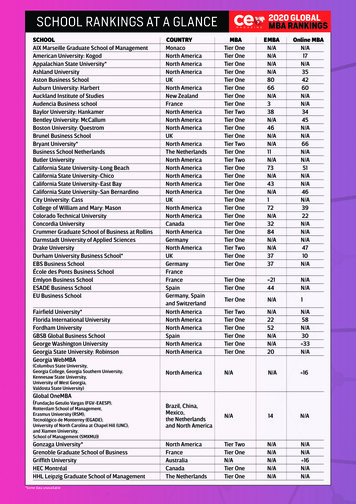
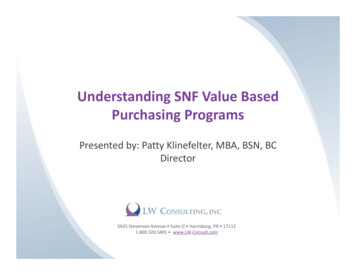

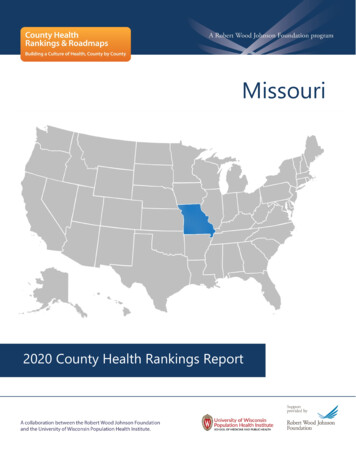
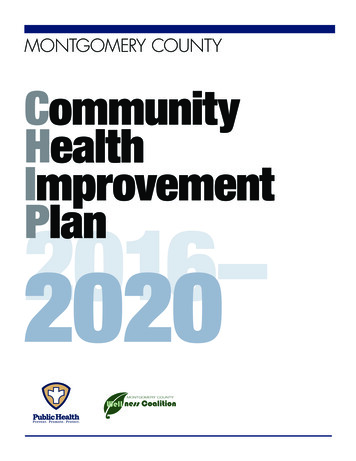


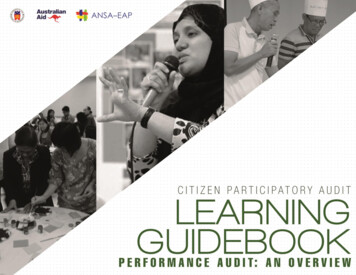
![project2 Encase.pptx [Read-Only]](/img/12/project2-encase.jpg)
